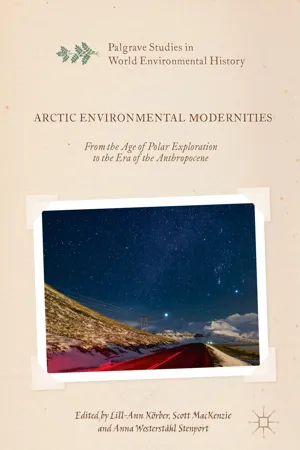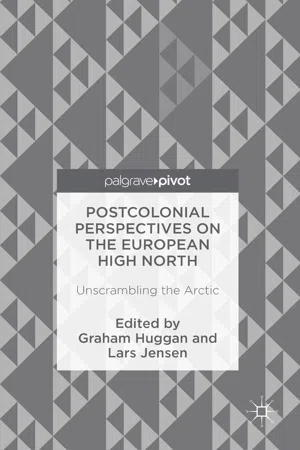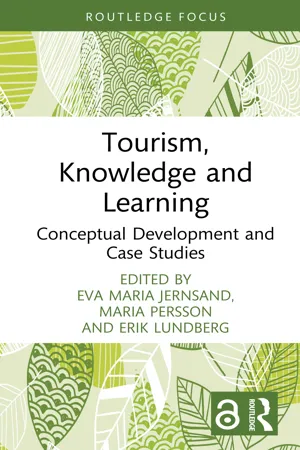Geography
Svalbard Case Study
The Svalbard Case Study focuses on the archipelago of Svalbard in the Arctic region, examining its unique geographical features, environmental challenges, and human impacts. It explores issues such as climate change, resource exploitation, and governance in the context of a rapidly changing polar environment. The case study provides insights into the complex interactions between physical geography, human activities, and environmental sustainability in the Arctic.
Written by Perlego with AI-assistance
Related key terms
Related key terms
1 of 4
Related key terms
1 of 3
3 Key excerpts on "Svalbard Case Study"
- eBook - ePub
Arctic Environmental Modernities
From the Age of Polar Exploration to the Era of the Anthropocene
- Lill-Ann Körber, Scott MacKenzie, Anna Westerståhl Stenport, Lill-Ann Körber, Scott MacKenzie, Anna Westerståhl Stenport, Lill-Ann Körber, Scott MacKenzie, Anna Westerståhl Stenport(Authors)
- 2017(Publication Date)
- Palgrave Macmillan(Publisher)
Why are the episodes described above relevant to action in the present? First, Svalbard continues to be characterized as a space for industry, a space for wilderness, and a space for cultural heritage protection, all within an overarching theme of legitimizing the influence of competing actors. Coal mining continues to be a significant economic activity, although few believe that it will survive the current low world market prices and the position of coal in current debates on anthropogenic climate change. This final factor is particularly noteworthy. Norway has pushed hard to portray Svalbard as a space for science—most notably climate research—symbolized by its stewardship of an international research community at Ny-Ålesund, formerly a coal mining settlement. UNIS was founded in 1993 and dominates the downtown of Longyearbyen. With the strengthened environmental law of 2002, responsible environmental management has become an increasingly important aspect of Norway’s claims to legitimate administration (further strengthened by its sponsorship of science). This applies also to the increasingly substantial efforts to preserve cultural heritage—including remains of mining. The power to govern Svalbard, and to determine its future, remains tied up with the production of narratives that construct the archipelago as a series of human and natural environments.An extension of this point with particular relevance to the present is that narratives about Svalbard cannot be considered as peculiarly “Arctic” in any self-evident sense, and that the demarcation of its natural and cultural heritage reflects values from far further south. To characterize a certain space as Arctic is to incorporate it within a system of meaning that is underdetermined by physical geography. The Arctic is defined differently depending on the context, from the Arctic Circle to climatological boundaries (such as the 10 °C isotherm) to definitions based upon administrative convenience. The history of Svalbard and its representations in the form of material remains (just like its present and its future) was framed within narratives constructed elsewhere. These are Norwegian stories, Soviet stories, as well as Swedish, British, and Dutch stories, more than they are Arctic stories. While the absence of an indigenous population makes these links appear starker than they would be in Greenland, northern Canada, or Siberia, we nevertheless argue that Arctic spaces are constructed in (and often for) southern consumption, and that historiographic and analytic frames based on cartographic location must be regarded with skepticism. The growth of the Arctic as an organizing category in the twenty-first century—inscribed upon bodies such as the Arctic Council and knowledge productions such as the Arctic Climate Impact Assessment—only strengthens the need to examine critically how and why that particular category has been employed and what narratives are supported by its use (Keskitalo 2004 - eBook - ePub
Postcolonial Perspectives on the European High North
Unscrambling the Arctic
- Graham Huggan, Lars Jensen, Graham Huggan, Lars Jensen, Graham Huggan, Lars Jensen(Authors)
- 2016(Publication Date)
- Palgrave Macmillan(Publisher)
1 ). At the same time, investigating the individual histories of specific Arctic territories can help contest the facile, essentialist narratives of progress, development, and ecological “state change” that are all too common to public and media discourse on Arctic places. An unscrambling of this space can help, not just to uncomplicate current understandings of Arctic scrambles, but also to carve out paths for more productive and critical reflection in the region’s distinctly complex times.It is thus important to assess circumpolar geopolitical developments in the Arctic in terms of both global international relations and individual domestic politics of the multiple countries involved (Pedersen 2009 ), as well as in relation to the multiple contemporary industrial and capitalist processes that are intertwined in the region. For this reason, I have divided this chapter into three primary sections, each of which looks at the role that these industries—here, coal mining, scientific research, and adventure tourism—have played and continue to play in Svalbard’s geopolitical positionality.Of Northern Extraction: From Coal Rush to Coal War
The 63,000 sq. km Svalbard archipelago is one of the planet’s most northerly and remotely inhabited settlements. Located at 78 degrees north, some 640 km north of the Norwegian mainland and 1300 km from the North Pole, this ice-packed archipelago is two-thirds covered by glaciers, and its soil is frozen to a depth of up to 500 m. Between mid-November and late January, the sun sinks a full eight degrees below the horizon, enveloping the land in complete polar darkness; the average temperature in February, Svalbard’s coldest month, is −16.2 C. In contrast to the winter, from mid-April to mid-August the islands enjoy 24-hour daylight, and once the snow has disappeared (usually by July) and the temperatures rise into the late teens, its umber, tussocky valleys are covered in wild flowers—poppy, polar willow, saxifrage—that take advantage of the long periods of daylight. The wildlife that calls Svalbard home includes over a hundred species of migratory birds, as well as arctic foxes, polar bears, and reindeer on land, and seals, walruses, and whales offshore. The islands’ western shores and coastal waters are warmed by the Gulf Stream, which melts sea ice and helps to keep the fjord open for maritime access for several months each year, while also making it relatively tolerable for human life. - eBook - ePub
- Eva Maria Jernsand, Maria Persson, Erik Lundberg, Eva Maria Jernsand, Maria Persson, Erik Lundberg(Authors)
- 2022(Publication Date)
- Routledge(Publisher)
Dowie, 2017 ), a part of the world with an intrinsic value and importance for the health of the planet. Eventually, in recent decades more lands have become protected, and Arctic tourism is increasingly framed in environmentally sound arrangements.Up until the 1950s, tourists encountered a Svalbard consistent with hundreds of years of visual representations and travel writings. Historical sites could be revisited and the land had not changed in any significant way. In the past 30 years this has changed dramatically, with a rapidly warming Arctic. Today, historical visual representations of Arctic destinations such as Svalbard play a very different role than originally intended, as valuable sources for time information on vanishing ice. Since 2010 we have established a collaborative transdisciplinary research platform monitoring the changing landscape in Svalbard’s Northwest Spitsbergen National Park, with a focus area spanning from Magdalenefjorden in the south to Fuglefjorden in the north. Supporting this is a vast and diverse archive of images from 19th-century science and travels. Images connected to European tourist cruises to Svalbard provide parts of a visual legacy of ice and the status of glaciers, but also an indication of what viewpoints were prioritized by the cruise ships. The frames of these viewpoints are good indicators of the aesthetic and cultural imaginaries carried by visitors of that time. The beginning of tourist cruises in the 1890s set the agenda for how to operate them and where; ships were used as a comfortable base, onboard photographers joined the crew and landings offered close encounters with glaciers or visits to historical remains of industry and exploration. In the beginning the ships were small, but they grew in size as the years went by and cruise-based tourism developed. The model for contemporary logistics in Arctic “mass tourism” has not changed in any dramatic way since the 1920s; large passenger cruisers are still used, as are protected, organized landings at key sites. The new development has been the concept of a more adventure-oriented tourism and its framing as ecologically aware tourism with an often knowledgeable and active smaller group of visitors wanting an embodied experience of the land, as well as an intellectual framing through guides and accompanying scientists or specialists from various relevant fields. This tourism is characterized by smaller ships but also an exclusivity generated by the high cost of operating such tours in these remote and wild areas. The number of passengers ranges from about 50 to 100, with the more exclusive cruises having about 10 to 20. The latter, fairly expensive travels normally operate on an open bridge policy, where passengers are able to move around the ship and can always enter the bridge and chat with the staff, including the captain. In travel packages aimed at these smaller groups, the awareness of the historical landscape is often based on images and maps from earlier visitors. Photographers often accompany both of these types of travel packages, continuing the tradition from the 1890s. The photographs produced from 1890 and onwards are often used in present-day tours when scientists or guides give lectures at landings, offering a unique on-site experience of shifting views of the land and glaciers in particular. This offers a very direct and clear comparison of changes over time, where we have to relate to the fact that, in both a practical and philosophical sense, we are visiting a different Arctic than our predecessors. Today, travelling to the Arctic regions is visiting ground zero of climate change.
Index pages curate the most relevant extracts from our library of academic textbooks. They’ve been created using an in-house natural language model (NLM), each adding context and meaning to key research topics.
Explore more topic indexes
Explore more topic indexes
1 of 6
Explore more topic indexes
1 of 4


